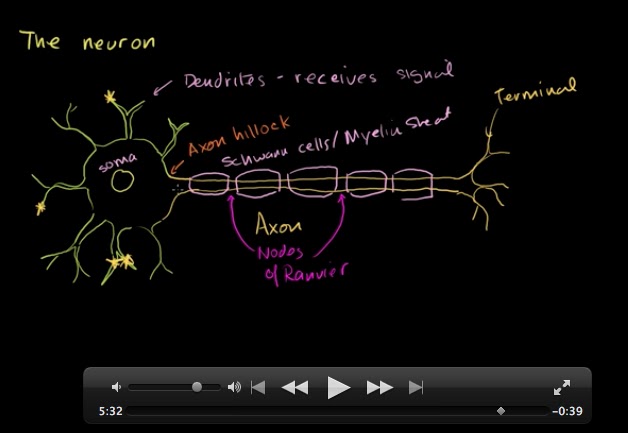While it is strictly speaking not an App, the Khan Academy videos are quite popular. So to begin, here is my first review of units related to the nervous system, beginning with the basic structure of the neuron.
By this time I often feel that just about every student in my psychology courses has had to at one time learned about the basic structure of the neuron either in middle school or high school. Nevertheless, instructors religiously review this information and occasionally I see some student examinations/essays that contain inaccuracies.
The unit on the neuron in the Khan Academy is essentially accurate, however there are just a few things that I believe could be corrected, missing or could be expanded upon.
- While the myelin sheath that insulates some axons is comprised of glial cells called Schwann cells, there are also some myelinated axons in which the sheath is comprised by a second type of glial cell -- oligodendroglia. Neurons within the central nervous system (brain and spinal cord) are myelinated by oligodendroglia and neurons in the peripheral nervous system are myelinated by Schwann cells.
- The Schwan cells and oligodendroglia form myelin in slightly different ways that have important consequences for their function and how susceptible they are to neurodegenerative disease.
- Khan does not mention that there are non-myelinated axons as well. These axons are typically extend over very short distances compared with myelinated axons.
- While were on the topic of the length of axons, Khan mentions that some myelinated axons may attain length of "several feet". The longest nerve in the human body is the sciatic nerve, a peripheral neuron that extends from the base of the spine to the big toe of each foot. Injury of this nerve can result in sciatica characterized by pain, weakness, tingling or numbness in the leg, foot or toes. [BONUS: It is a mixed nerve; one that contains both sensory and motor fibers]. So it would seem logical that the sciatic nerve contains the longest motor axons (maybe 0.5-1 meters depending upon the height a person attains in adulthood). In his blog Oscillatory Thoughts, Bradley Voytek speculates that sensory sciatic neurons may have even longer axons - ones that might extend from the lower spinal cord at least as high as the brain stem. By the way, using similar logic, the sensory neurons of the sciatic nerve may also have the longest dendrites! What animal is likely to have the longest axon? Voytek suggest it would likely be the blue whale.
- The neuron that is in drawn is the quintessential multipolar motor neuron. This is generally the image of a neuron that you find in most introductory psychology or neurobiology textbooks. But there is a vast array of different types of neurons with different arrangements of their dendrites, soma and axon. Most intermediate level textbooks also distinguish between bipolar, unipolar, multipolar neurons.
BOTTOM LINE: This Khan unit is a good review of the basic structural plan of the typical multipolar motor neuron for middle and high school students. Some information that is likely to be required in introductory and higher level college courses is omitted.
LINK: Khan Academy Anatomy of a Neuron
LINK: Khan Academy Anatomy of a Neuron


No comments:
Post a Comment